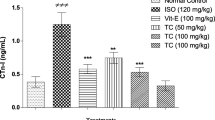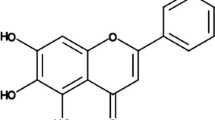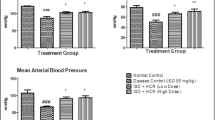Abstract
The present study demonstrated prophylactic and therapeutic potential of Terminalia arjuna bark extract in isoproterenol (ISO)-induced chronic heart failure (CHF). Fifteen days after injection of ISO (85 mg/kg twice at an interval of 24 h, s.c), rats showed decline in maximal rate of rise and fall of left ventricular pressure (LV (dP/dt)max and LV (dP/dt)min), cardiac contractility index (LV (dP/dt)max/LVP), cardiac output and rise in LV end-diastolic pressure. CHF rats showed a significant increase in serum creatine kinase isoenzyme-MB (CK-MB) and malondialdehyde levels, as well as fall in the activities of superoxide dismutase, reduced glutathione. Altered lipid profile and increased level of cytokine tumour necrosis factor-α (TNF-α) along with histological changes in heart were also observed in CHF rats. T. arjuna bark extract (500 mg/kg, p.o) treatment prior and 15 days after ISO injection significantly attenuated cardiac dysfunction and myocardial injury in CHF rats. Cardioprotective action of T. arjuna was comparable to fluvastatin, a synthetic drug. The results suggest that T. arjuna bark extract has a significant prophylactic and therapeutic beneficial effect on protection of heart against ISO-induced CHF possibly through maintaining endogenous antioxidant enzyme activities, inhibiting lipid peroxidation and cytokine levels.




Similar content being viewed by others
References
Lloyd-Jones, D. M., Larson, M. G., Leip, E. P., Beiser, A., D’Agostino, R. B., Kannel, W. B., et al. (2002). Lifetime risk for develo** congestive heart failure: The Framingham heart study. Circulation, 106, 3068–3072.
Ho, K. K., Pinsky, J. L., Kannel, W. B., & Levy, D. (1993). The epidemiology of heart failure: The Framingham Study. Journal of the American College of Cardiology, 22, 6–13.
Chae, C. U., Pfeffer, M. A., Glynn, R. J., Mitchell, G. F., Taylor, J. O., & Hennekens, C. H. (1999). Increased pulse pressure and risk of heart failure in the elderly. JAMA, 281, 634–639.
Middlekauff, H. L. (1997). Mechanisms and implications of autonomic nervous system dysfunction in heart failure. Current Opinion in Cardiology, 12, 265–275.
Zucker, I. H., & Wang, W. (1991). Reflex control of renal sympathetic nervous activity in heart failure. Herz, 16, 82–91.
DiBona, G. F., & Sawin, L. L. (1995). Increased renal nerve activity in cardiac failure: Arterial vs. cardiac baroreflex impairment. American Journal of Physiology. Regulatory, Integrative and Comparative Physiology, 268, 112–116.
Levine, B., Kalman, J., Mayer, L., Fillit, H. M., & Packer, M. (1990). Elevated circulating levels of tumour necrosis factor in severe chronic heart failure. New England Journal of Medicine, 323, 236–241.
Landmesser, U., Spiekermann, S., Dikalov, S., Tatge, H., Wilke, R., Kohler, C., et al. (2002). Vascular oxidative stress and endothelial dysfunction in patients with chronic heart failure: Role of xanthine-oxidase and extracellular superoxide dismutase. Circulation, 106, 3073–3078.
Shah, A. M., & Channon, K. M. (2004). Free radicals and redox signalling in cardiovascular disease. Heart, 90, 486–487.
Giardano, F. J. (2005). Oxygen, oxidative stress, hypoxia, and heart failure. Journal of Clinical Investigation, 115, 500–508.
Bozkurt, B., Kribbs, S. B., Clubb, F. J., Michael, L. H., Didenko, V. V., Hornsby, P. J., et al. (1998). Pathophysiologically relevant concentrations of tumour necrosis factor-α promote progressive left ventricular dysfunction and remodeling in rats. Circulation, 97, 1382–1391.
Cleland, J. G. F., Gemmell, I., Khand, A., & Body, A. (1999). Is the prognosis of heart failure improving? European Journal of Heart Failure, 1, 229–241.
Horwich, T. B., MacLellan, W. R., & Fonarow, G. C. (2004). Statin therapy is associated with improved survival in ischemic and nonischemic heart failure. Journal of the American College of Cardiology, 43, 642–648.
Liao, J. K., & Laufs, U. (2005). Pleiotropic effects of statins. Annual Review of Pharmacology and Toxicology, 45, 89–118.
Grundy, S. M. (2005). The issue of statin safety: Where do we stand? Circulation, 111, 3016–3019.
Gotto, A. M. (2006). Statins, cardiovascular disease and drug safety. American Journal of Cardiology, 97, 3C–5C.
Vaidya, A. B. (1994). Terminalia arjuna in cardiovascular therapy. The Journal of the Association of Physicians of India, 42, 281–282.
Gupta, R., Singhal, S., Goyle, A., & Sharma, V. N. (2001). Antioxidant and hypocholesterolemic effects of Terminalia arjuna tree-bark powder: A randomized placebo-controlled trial. The Journal of the Association of Physicians of India, 49, 231–235.
Dwivedi, S. (1994). Antianginal and cardioprotective effects of Terminalia arjuna, an indigenous drug, in coronary heart disease. The Journal of the Association of Physicians of India, 42, 287–289.
Teerlink, J. R., Pfeffer, J. M., & Pfeffer, M. A. (1998). Effect of left ventricular sphericity on the evolution of ventricular dysfunction in rats with diffuse isoproterenol-induced myocardial necrosis. Journal of Cardiac Failure, 4, 45–56.
Grimm, D., Elsner, D., Schunkert, H., Pfeffer, M., Griese, D., Bruckschlegel, G., et al. (1998). Development of heart failure following isoproterenol administration in the rat: Role of the renin- angiotensin system. Cardiovascular Research, 37, 91–100.
Hayashidani, S., Tsutsui, H., Shiomi, T., Suematsu, N., Kinugawa, S., Ide, T., et al. (2002). Fluvastatin, a 3-hydroxy-3-methylglutaryl coenzyme a reductase inhibitor, attenuates left ventricular remodeling and failure after experimental myocardial infarction. Circulation, 105, 868–873.
Gauthaman, K., Maulik, M., Kumari, R., Manchanda, S. C., Dinda, A. K., & Maulik, S. K. (2001). Effect of chronic treatment with bark of Terminalia Arjuna: A study on the isolated ischemic-reperfused rat heart. Journal of Ethnopharmacology, 75, 197–201.
Bos, R., Mougenot, N., Findji, L., Médiani, O., Vanhoutte, P. M., & Lechat, P. (2005). Inhibition of catecholamine-induced cardiac fibrosis by an aldosterone antagonist. Journal of Cardiovascular Pharmacology, 45, 8–13.
Rona, G. (1985). Catecholamine cardiotoxicity. Journal of Molecular and Cellular Cardiology, 17, 291–306.
Yeager, J. C., & Iams, S. G. (1981). The hemodynamics of isoproterenol-induced cardiac failure in the rat. Circulatory Shock, 8, 151–163.
Dhalla, K. S., Rupp, H., Beamish, R. E., & Dhalla, N. S. (1996). Mechanisms of alterations in cardiac membrane Ca2+ transport due to excess catecholamines. Cardiovascular Drugs and Therapy, 10, 231–238.
Singal, P. K., Beamich, R. E., & Dhalla, N. S. (1983). Potential oxidative pathways of catecholamines in the formation of lipid peroxides and genesis of heart disease. Advances in Experimental Medicine and Biology, 161, 391–440.
Grimm, D., Holmer, S. R., Riegger, G. A. J., & Kromer, E. P. (1999). Effects of beta-receptor blockade and angiotensin II type I receptor antagonism in isoproterenol- induced heart failure in the rat. Cardiovascular Pathology, 8, 315–323.
Balakumar, P., & Singh, M. (2006). The possible role of caspase-3 in pathological and physiological cardiac hypertrophy in rats. Basic and Clinical Pharmacology and Toxicology, 99, 418–424.
Zhong, D. Z., Min, C. X., Siyu, S., Dan, D., & Hui, C. (2008). From neuroendocrine activation to intracardiac cyclic nucleotides in chronic heart failure of rats induced by isoproterenol. Journal of Chinese Clinical Medicine, 3, 601–608.
Yeager, J. C., & Whitehurst, M. E. (1982). Verapamil prevents isoproterenol induced cardiac failure in rats. Life Sciences, 30, 299–306.
Teerlink, J. R., Pfeffer, J. M., & Pfeffer, M. A. (1994). Progressive ventricular remodeling in response to diffuse isoproterenol- induced myocardial necrosis in rats. Circulation Research, 75, 105–113.
Nirmala, C., & Puvanakrishnan, R. (1996). Protective role of curcumin against isoproterenol induced myocardial infarction in rats. Molecular and Cellular Biochemistry, 159, 85–93.
Zhou, R., Xu, Q., Zheng, P., Yan, L., Zheng, J., & Dai, G. (2008). Cardioprotective effect of fluvastatin on Isoproterenol-induced myocardial infarction in rat. European Journal of Pharmacology, 586, 244–250.
Kumar, S., Enjamoori, R., Jaiswal, A., Ray, R., Seth, S., & Maulik, S. K. (2009). Catecholamine-induced myocardial fibrosis and oxidative stress is attenuated by Terminalia arjuna (Roxb.). The Journal of Pharmacy and Pharmacology, 61, 1529–1536.
Rajadurai, M., & Prince, P. S. M. (2006). Preventive effect of naringin on lipids, lipoproteins and lipid metabolic enzymes in isoproterenol-induced myocardial infarction in Wistar rats. Journal of Biochemical and Molecular Toxicology, 20, 191–197.
Mann, D. L. (2005). Targeted anticytokine therapy and the failing heart. American Journal of Cardiology, 95, 9–16.
Node, K., Fujita, M., Kitakaze, M., Hori, M., & Liao, J. K. (2003). Short-term statin therapy improves cardiac function and symptoms in patients with idiopathic dilated cardiomyopathy. Circulation, 108, 839–843.
Acknowledgments
Authors would like to acknowledge Professor M.S.Y. Khan, Jamia Hamdard (India) for providing T. arjuna bark extract and Central Council for Research in Unani Medicine (CCRUM, Government of India) for providing partial financial assistance for the present work.
Author information
Authors and Affiliations
Corresponding author
Rights and permissions
About this article
Cite this article
Parveen, A., Babbar, R., Agarwal, S. et al. Mechanistic Clues in the Cardioprotective Effect of Terminalia Arjuna Bark Extract in Isoproterenol-Induced Chronic Heart Failure in Rats. Cardiovasc Toxicol 11, 48–57 (2011). https://doi.org/10.1007/s12012-010-9099-2
Published:
Issue Date:
DOI: https://doi.org/10.1007/s12012-010-9099-2




